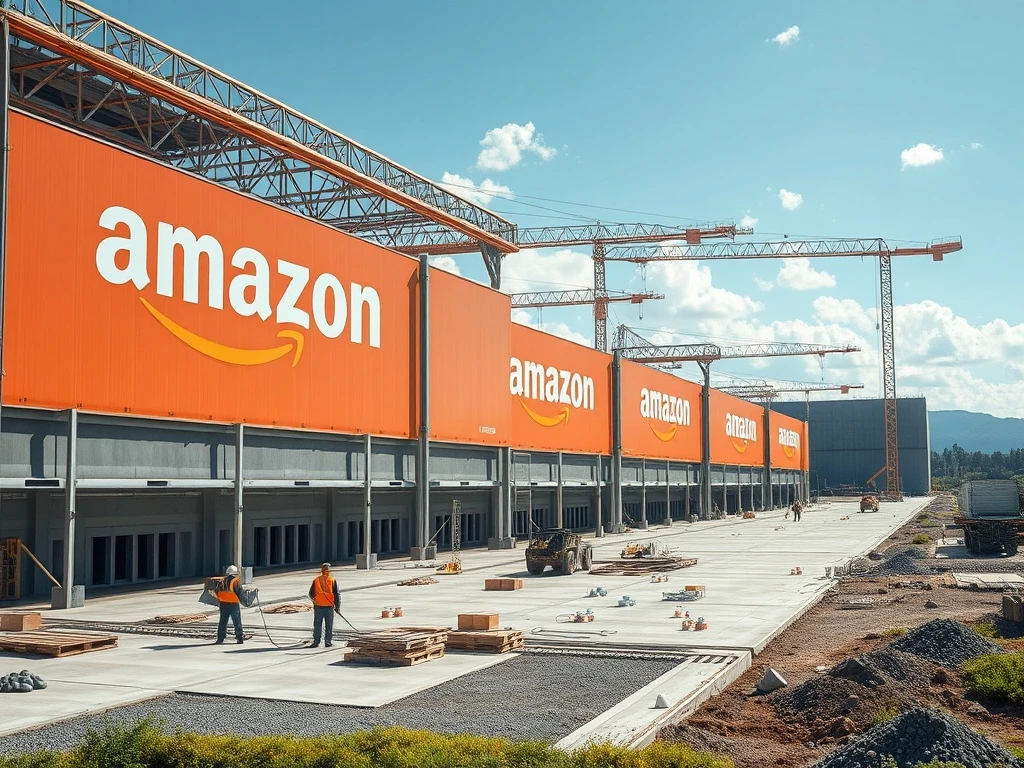The global construction industry faces an urgent challenge: reducing its massive carbon footprint. Traditional cement production, a foundational element of modern infrastructure, accounts for a significant portion of worldwide CO2 emissions. However, a promising new chapter unfolds through a strategic collaboration between e-commerce giant Amazon (NASDAQ: AMZN) and innovative startup Brimstone. This partnership actively advances the development and adoption of lower-carbon cement, signaling a transformative shift towards truly sustainable building practices. This initiative offers profound implications for businesses prioritizing greener supply chains. It also impacts the future trajectory of large-scale infrastructure development worldwide.
Pioneering Progress: Amazon and Brimstone’s Lower-Carbon Cement Breakthrough
Amazon and Brimstone recently unveiled the successful outcomes of initial tests for Brimstone’s groundbreaking lower-carbon cement. This material, specifically an Ordinary Portland Cement (OPC), demonstrated exceptional performance in critical concrete construction evaluations. These rigorous trials were meticulously designed in close collaboration with Amazon’s seasoned concrete consultants. They aimed to assess vital properties such as workability, compressive strength, and overall material integrity. Crucially, the test results confirmed Brimstone’s OPC fully complied with stringent ASTM C150 requirements. It also performed comparably well with conventional materials currently employed across Amazon’s extensive building portfolio. This early success represents a pivotal milestone. It validates the practical viability of sustainable alternatives in mainstream construction.
Understanding Brimstone’s Innovative Cement Production Process
Brimstone’s patented technology offers a distinct advantage in the quest for sustainable materials. The company developed a breakthrough process. It allows for the co-production of multiple essential industrial materials. These include portland cement, vital supplementary cementitious materials (SCM), and smelter-grade alumina. This innovative method is designed for superior efficiency and economic viability. Furthermore, it significantly enhances environmental sustainability. Cody Finke, Brimstone’s visionary co-founder and CEO, emphasized the key benefit. Brimstone produces ASTM C150 Ordinary Portland Cement. This particular type of cement is the most widely used globally. Consequently, its path to broad commercialization appears well-defined. Existing regulatory frameworks, established industry know-how, and proven material safety protocols readily support its adoption. This ensures a seamless integration for the construction sector. Brimstone’s lower-carbon cement provides a practical, industry-standard solution for contemporary building requirements.
Securing Future Supply: A Landmark Commercial Agreement for Lower-Carbon Cement
Building on these highly encouraging initial test outcomes, Amazon has solidified its commitment. The company formally signed a commercial agreement. This landmark deal strategically reserves annual volumes of Brimstone’s OPC and SCM. These critical materials will be sourced directly from Brimstone’s forthcoming production plant. This proactive commitment clearly underscores Amazon’s profound confidence in Brimstone’s innovative technology. It also signifies a decisive strategic move towards cultivating greener, more sustainable supply chains across its operations. Moreover, this robust partnership lays the groundwork for even more comprehensive future testing. The companies plan extensive concrete evaluations throughout 2025 and 2026. These will meticulously assess critical performance aspects. These include long-term durability, sulfate resistance, and aggregate reactivity potential. The expanded testing program will utilize significantly larger material volumes. These will be produced at Brimstone’s facility in Oakland, California. Ultimately, this collaboration aims to scale the application of lower-carbon cement across Amazon’s vast infrastructure. It sets a new precedent for industry adoption.
Driving Industry-Wide Change and Amazon’s Sustainability Vision
Asad Jafry, Director of Global Energy, Sustainability & Automation at Amazon, expressed considerable optimism regarding the project’s potential. He stated, “These initial results are encouraging. They demonstrate the potential for Brimstone’s innovative materials. They can scale across our buildings portfolio. This will significantly reduce the carbon footprint of concrete.” Indeed, the construction sector represents a major contributor to global carbon dioxide emissions. Traditional cement production processes demand extremely high temperatures. This leads to the release of substantial amounts of CO2. Brimstone’s alternative method offers a highly viable solution. It promises to deliver industry-standard materials with a profoundly reduced environmental impact. This significant development could very well catalyze widespread adoption of lower-carbon cement throughout the entire construction industry. It aligns perfectly with global initiatives to combat climate change. Many corporations now prioritize sustainable practices as a core business objective. This pioneering partnership provides a compelling blueprint for other organizations to emulate. It showcases a tangible commitment to environmental stewardship.
Market Dynamics and Investor Insights: AMZN Stock Performance and ESG Impact
This groundbreaking collaboration carries substantial implications for investors and market dynamics. Amazon’s proactive commitment to sustainable innovation can profoundly enhance its brand reputation. It may also attract a growing segment of environmentally conscious investors. The company’s stock, AMZN, stands to benefit from such forward-thinking environmental, social, and governance (ESG) initiatives. Sustainable business practices are increasingly influencing investment decisions across global markets. As a result, companies consistently demonstrating strong ESG performance frequently gain a competitive advantage. This strategic move firmly positions Amazon as a prominent leader in green technology adoption. It clearly demonstrates a deep dedication to systematically reducing its operational carbon footprint. The successful integration of lower-carbon cement into Amazon’s extensive building portfolio could establish a new, industry-wide benchmark. This potentially opens vast new markets for Brimstone and other providers of sustainable construction materials. Furthermore, this initiative strongly reinforces Amazon’s broader Climate Pledge goals. The market will undoubtedly monitor the progression of this partnership closely. Successful scaling could create a valuable new revenue stream for Brimstone. It could also yield significant long-term cost efficiencies for Amazon. This strategic alliance powerfully underscores the escalating importance of sustainability within contemporary corporate strategy. It impacts both operational efficiency and crucial investor relations.
Future Outlook and Scaling Sustainable Cement Solutions
The path forward involves further rigorous testing and strategic scaling. The companies plan to expand their testing program. This includes evaluating durability, sulfate resistance, and aggregate reactivity potential across a wider range of concrete mix designs. This ensures the lower-carbon cement meets all performance requirements for diverse applications. Brimstone’s facility in Oakland, California, will play a crucial role. It will produce the larger volumes of material needed for these extensive tests. The successful completion of this testing phase is critical. It will pave the way for full commercialization and widespread adoption. Brimstone’s unique process, which co-produces cement with other industrial materials, offers a compelling economic model. This integrated approach can make sustainable materials more cost-competitive. It accelerates market acceptance. As global demand for green building solutions grows, partnerships like this become indispensable. They demonstrate a tangible commitment to a more sustainable future. This collaborative effort sets a powerful example for the entire construction industry.
In conclusion, the strategic partnership between Amazon and Brimstone marks a pivotal moment in the evolution of sustainable construction. Their collective advancement of lower-carbon cement represents a significant leap forward. Initial test results are highly promising. The commercial agreement secures future supply. This collaboration not only delivers substantial benefits to both companies but also offers a genuinely scalable solution for reducing global carbon emissions. As the world increasingly shifts towards a greener, more responsible future, such innovations will become critically vital. This pioneering initiative powerfully demonstrates how strong corporate commitment can drive profound and meaningful environmental change on a global scale.
Frequently Asked Questions (FAQs)
Q1: What is lower-carbon cement?
A1: Lower-carbon cement refers to cement produced using innovative processes that significantly reduce the carbon dioxide emissions associated with its manufacturing. Traditional cement production is highly energy-intensive and releases large amounts of CO2. Brimstone’s method, for instance, aims to mitigate these emissions by using alternative raw materials and more efficient processes.
Q2: How does Brimstone’s technology differ from traditional cement production?
A2: Brimstone has developed a unique process that co-produces portland cement, supplementary cementitious materials (SCM), and smelter-grade alumina. This method is designed to be more efficient, economical, and sustainable than conventional cement manufacturing, which typically relies on calcining limestone at very high temperatures, a major source of CO2.
Q3: What are the key benefits of Amazon’s collaboration with Brimstone?
A3: This collaboration allows Amazon to integrate more sustainable materials into its vast building portfolio, significantly reducing its carbon footprint. For Brimstone, it provides a major commercial partner, validating its technology and accelerating its path to commercialization. It also sets a precedent for sustainable practices in large-scale construction.
Q4: How will this partnership impact Amazon’s sustainability goals?
A4: Amazon has committed to The Climate Pledge, aiming for net-zero carbon by 2040. Adopting lower-carbon cement directly contributes to this goal by reducing emissions from its extensive construction activities. It reinforces Amazon’s leadership in corporate sustainability and ESG initiatives.
Q5: What are the next steps for the Amazon-Brimstone collaboration?
A5: Following successful initial tests, the companies plan more extensive concrete tests in 2025 and 2026. These will evaluate durability, sulfate resistance, and aggregate reactivity across a wider range of concrete mix designs. This expanded testing will use larger material volumes from Brimstone’s Oakland facility, paving the way for full commercialization and scaling.
Q6: Could this technology be adopted widely across the construction industry?
A6: Yes, Brimstone’s production of ASTM C150 Ordinary Portland Cement, the most widely used cement, makes its technology highly compatible with existing industry standards and regulations. This compatibility, combined with competitive pricing and environmental benefits, positions lower-carbon cement for widespread adoption across the global construction sector.
























